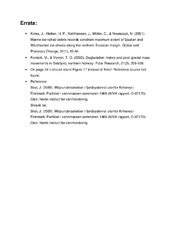| dc.contributor.advisor | Forwick, Matthias | |
| dc.contributor.advisor | Junttila, Juho | |
| dc.contributor.advisor | Baeten, Nicole Jeanne | |
| dc.contributor.advisor | Lepland, Aivo | |
| dc.contributor.author | Ladstein, Anette Klev | |
| dc.date.accessioned | 2018-06-01T12:21:40Z | |
| dc.date.available | 2018-06-01T12:21:40Z | |
| dc.date.issued | 2018-05-15 | |
| dc.description.abstract | The aim for this study is to characterise and distinguish natural and anthropogenic deposition in Bøkfjorden, and to identify the spreading and the impact of submarine tailings placements on the seafloor. The analyses are based on the integration of swath bathymetry, high-resolution seismics and multi-proxy analyses of four sediment cores
The physical properties, including magnetic susceptibility and wet-bulk density, of the sediment cores were measured with a Multi Sensor Core Logger (MSCL). Element-geochemical measurements were performed with an Avaatech XRF core scanner. In addition, grain-size distribution analyses and measurements of the shear strength was carried out.
The bathymetry reveals a generally northwards sloping of the sea floor that is cut by a channel, which acts as a pathway for submarine tailings placements and the channel follows the deep part of the fjord basin.
The high-resolution seismics data and sediment cores revealed three different sedimentary environment: glacier proximal (deglaciation), open marine (postglacial) and anthropogenic (mine tailings placements). The glacial proximal stratification reflected repeating changes in the depositional environment. The open marine environment is reflected as massive deposits accumulated from mass wasting and suspension settling. Anthropogenic deposits are found in the form of submarine tailing placements. The submarine tailings reflected massive sedimentation and repeated change in the deposition of tailings. The majority of the submarine tailings placements occurs close to the depositional site in the vicinity of the fjord head. However, these deposits became unstable occasionally and the failed tailings were transferred over at least 13.2 km through the channel and into the deeper parts of the fjord. | en_US |
| dc.identifier.uri | https://hdl.handle.net/10037/12820 | |
| dc.language.iso | eng | en_US |
| dc.publisher | UiT Norges arktiske universitet | en_US |
| dc.publisher | UiT The Arctic University of Norway | en_US |
| dc.rights.accessRights | openAccess | en_US |
| dc.rights.holder | Copyright 2018 The Author(s) | |
| dc.rights.uri | https://creativecommons.org/licenses/by-nc-sa/3.0 | en_US |
| dc.rights | Attribution-NonCommercial-ShareAlike 3.0 Unported (CC BY-NC-SA 3.0) | en_US |
| dc.subject.courseID | GEO-3900 | |
| dc.subject | VDP::Mathematics and natural science: 400::Geosciences: 450::Marine geology: 466 | en_US |
| dc.subject | VDP::Matematikk og Naturvitenskap: 400::Geofag: 450::Marin geologi: 466 | en_US |
| dc.subject | VDP::Mathematics and natural science: 400::Geosciences: 450::Sedimentology: 456 | en_US |
| dc.subject | VDP::Matematikk og Naturvitenskap: 400::Geofag: 450::Sedimentologi: 456 | en_US |
| dc.title | Natural and anthropogenic deposition in Bøkfjorden | en_US |
| dc.type | Master thesis | en_US |
| dc.type | Mastergradsoppgave | en_US |


 English
English norsk
norsk

